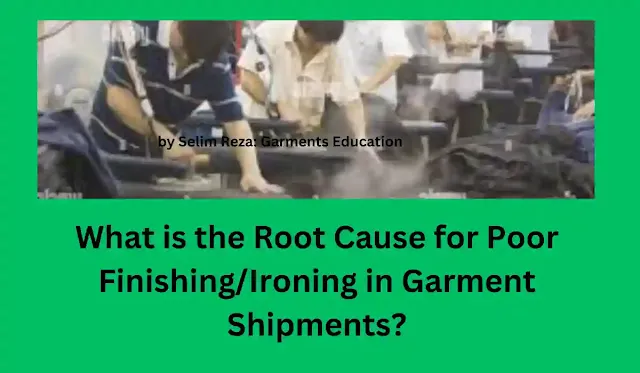Root Cause for Poor Finishing in Garment Shipments?
Ensuring High-quality Finishing and Ironing of Garments before shipping is critical for any clothing manufacturer or exporter. Poor finishing can lead to wrinkled or unevenly pressed garments, which not only affects the appearance but also tarnishes the brand’s reputation.
In this blog, we’ll explore the root causes behind poor finishing/ironing in garment shipments and how to address them.

1. Inadequate Training of Workforce
One of the leading causes of Poor Garment Finishing is a lack of proper training for ironing staff. Finishing requires precision, technique, and knowledge of fabric properties. Without the right skills, operators may not handle the garments properly, leading to wrinkles, uneven ironing, and fabric burns.
- Solution: Regular training sessions for employees focusing on different fabrics and garment types. Provide hands-on instruction in the correct use of ironing equipment and quality checks.
2. Improper Use of Ironing Equipment
Using the wrong ironing temperature or pressing techniques can ruin the finish of garments. Different fabrics require different levels of heat, steam, and pressure. Overheating or underheating can result in poor finishes, fabric shine, or even permanent damage to delicate textiles.
- Solution: Equip the finishing department with adjustable, high-quality irons and steamers. Operators should be trained to adjust temperatures based on fabric type to avoid damaging the garments.
3. Inconsistent Steam Supply
Steam plays a vital role in the finishing process, helping to relax fabric fibers and remove wrinkles effectively. If the steam supply is inconsistent or insufficient, it can lead to uneven pressing, resulting in poorly finished garments.
- Solution: Ensure a consistent steam supply by regularly maintaining steam generators and equipment. Monitor the water levels and steam pressure to avoid disruptions during the ironing process.
4. Poor Handling of Garments Before Ironing
Before garments are ironed, improper handling, such as excessive folding, stacking, or cramming into boxes, can cause creases that are difficult to remove during the finishing process. These creases may result in garments appearing wrinkled even after ironing.
- Solution: Implement a system for carefully hanging or laying garments flat before they go through the ironing process. Handling should be minimized to prevent unnecessary creases.
5. Use of Incorrect Finishing Chemicals
Some garment manufacturers use finishing chemicals, such as softeners or starch, to enhance the look and feel of the garment. However, the misuse or overuse of these chemicals can leave marks, residue, or stiffness, affecting the final appearance.
- Solution: Use the right type and amount of finishing chemicals as per the fabric's needs. Test the chemical solutions on a small batch before applying them to the entire production.
6. Poor Quality Control Checks
Without proper quality control measures in place, garments that haven’t been finished properly can go unnoticed. Lack of post-ironing inspections means that wrinkles, shiny spots, or burns may slip through, ultimately reaching the buyer.
- Solution: Set up a dedicated quality control team to inspect each garment after ironing. They should check for wrinkles, fabric shine, and overall garment appearance to ensure each piece meets the required standards.
7. Humidity and Environmental Factors
Environmental conditions, especially humidity levels, can affect how garments react during ironing. High humidity can cause garments to re-wrinkle shortly after being pressed, making them look poorly finished upon arrival at their destination.
- Solution: Maintain an appropriate temperature and humidity level in the ironing and packing area. Consider using dehumidifiers or climate control systems to regulate the environment and avoid moisture buildup in garments.
8. Over-Packing in Shipment Boxes
Even if garments are finished perfectly, over-packing them into shipment boxes can cause wrinkles during transit. Tight packing leads to pressure marks and folds, diminishing the quality of the finish by the time the garments reach the customer.
- Solution: Pack garments carefully with adequate space between each item. Use tissue paper or other packing materials to prevent garments from being squashed together. Ensure the shipping boxes are not overfilled.
Conclusion
Poor finishing or ironing in garment shipments can result from several factors, including workforce training, improper use of equipment, steam supply issues, and environmental conditions. Addressing these root causes through better equipment, employee training, and improved handling procedures will ensure a flawless finish that maintains garment quality from the factory to the customer.
By focusing on these key areas, garment manufacturers can improve the overall quality of their shipments and enhance customer satisfaction.



.png)
.png)



